Xenogears: Alpha and Omega
In 1998, Xenogears seemed poised to usher in a new wave of epic sci-fi RPGs with complex and mature storylines. 15 years later, Xenogears stands alone as one of the only epic sci-fi RPGs ever released. What once seemed to be the first step into a new era is now better viewed as the culmination of another: the late-’90s boom in story-based RPGs. Even so, Xenogears still retains plenty of devoted (if nowadays, mostly quiet) admirers, and many of its unique accomplishments have never been matched. On the fifteenth anniversary of the game’s US release, it’s worth looking back at why it still stands out from the pack.
Time Immemorial
Perhaps the main reason Xenogears’s reputation hasn’t enjoyed more of a revival is one of its defining characteristics: its enormous length. A full playthrough of Xenogears–which is pretty much the entirety of the game, as there are few optional areas–usually clocks in at about 80 hours. That certainly makes it intimidating to consider replaying; don’t expect to see this one at Awesome Games Done Quick.
But as an experience–then or now–it’s still one of a kind. Those 80 hours have surprising little filler, and Xenogears makes its length more palatable by neatly dividing itself into subordinate story arcs, the way a TV show might build towards and provide closure in a season finale while also continuing a broader storyline across multiple seasons. Take the first arc: After the destruction of their hometown, protagonist Fei and his mentor Citan are thrust into the desert, where they meet up with deposed prince Bart. From there, Fei’s involvement in this story continues through a series of missions to escape a cave, rescue Bart’s cousin, and ultimately attempt to liberate this kingdom. Although it makes up just a small portion of Xenogears’s story, this arc comes complete with its own minor characters (the usurper Shakhan, the reckless captain Vanderkaum, and Bart’s crew), set pieces (a martial arts tournament, a sandship raid), and a climactic boss battle against Vanderkaum to cap off the arc. The fact that there’s always an immediate goal in front of Fei ensures a sense of progress. At the same time, Fei’s adventures in the desert tease bigger issues: Shakhan is backed by the global superpower Solaris, a mysterious man in black armor keeps trying to goad Fei into combat, and fossils in a cave suggest a strangely abrupt origin for humanity.
These details are gradually expanded over the course of subsequent arcs, and by the end of the saga–in fact, well before–Shakhan seems like small potatoes. It’s simply impossible to understate the game’s scope; the story spirals out from Fei fleeing for his life to political intrigue to global warfare to God and the ultimate fate of humanity–while also spiraling in towards Fei’s internal psychological struggles with his true, killer personality, Id.
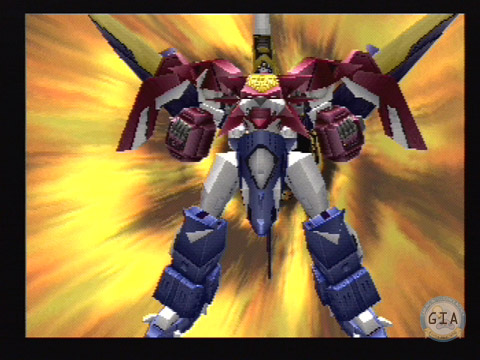
The Elements
But the high stakes never feel unearned. Each expansion of the narrative emerges gradually from the more elementary struggles, and the eschatological struggles are grounded in human consequence. One of the story’s most tragic figures is Hammer, who tags along for much of the game as an item salesman but is eventually flipped by the enemy empire and must be slain by his former friends. It’s a rare acknowledgement in a game that not everyone makes heroic decisions under duress. There’s even the occasional dose of humor, including snappy dialogue (Hammer’s famous gloating about his “mad skillz”), parody (the Elements team members combine their mecha Voltron-style; another cutscene references Macross) and sheer goofiness (one party member, Chu-Chu, is a pink mouse-like creature who flirts with Fei and demands a ~backrub~ before she rejoins the fighting roster).
And outside of some relatively minor gaps left when the creators ran out of development time, it’s all remarkably coherent. When all the nuances of the plot are stitched together, they reveal a surprisingly mechanistic, clockwork-universe view of the world in which each decision flows naturally from the characters’ goals and knowledge. Even a profoundly silly story about the death of the Chu-Chu Tribe’s “guardian god” from a fireball out of the sky turns out to foreshadow the literal spaceship crash that sets Xenogears’s plot into motion. There are few coincidences, miraculous interventions, or sudden changes of motivation, and even the villains act more from self-preservation or their inborn programming than mustache-twirling evil. Perhaps the best example of this characterization moderation is when Citan reveals himself as a spy who has been tracking Fei to determine whether his powers are a threat to the world. The game resists the temptation to have Citan either turn into a complete monster or completely flip to Fei’s side; instead, Citan simply concludes that Fei is not a threat and carries on, staying true to his original motives.
A few of the more subtle points are left up to the player to piece together. The game never explicitly points out that the military installation Ft. Jasper is actually one of the gun pods from the spaceship in the opening movie; it’s left to the player to make the connection. Discovering these connections is how the player fully explores and understands the game world, the same as uncovering a Heart Container in Zelda or a faster route in Gran Turismo.
Heroes and Villains
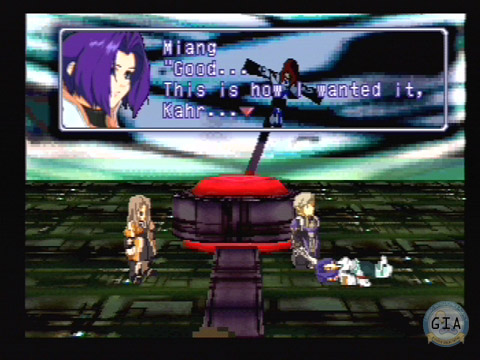
Heroes and Villains
Xenogears’s slow-burn approach applies particularly well to one of the most compelling villains in an RPG. Miang first appears as the subservient assistant to enemy captain Ramsus and is easy to pigeonhole as a “toady” character. But she keeps turning up in more and more conversations with important figures, and her importance gradually becomes clearer. In fact, not only is Ramsus wrapped around Miang’s finger, so is the rest of the world. Even when Ramsus thinks he’s getting revenge against her, he’s simply picking up the bait she dropped. The fact that there’s never any sudden, cheesy “reveal” of her true motives, only a slowly growing sense of suspicion, makes her all the more sinister.
Krelian, the other principal antagonist, is also a master manipulator. Despite frequent on-screen appearances in the second half of the game, Krelian and the player never even fight once. Although Krelian’s remoteness sometimes makes him a less compelling adversary–and his motivations never rise above standard bishounen angst–it’s a bold move to create a video game villain that the player never gets to beat up. Allowing Krelian to work behind the scenes as a scientist lets the story flow much more naturally than if he were forced into a fistfight that would fit neither his character nor the plot.
Indeed, Xenogears is brave in its treatment of many character tropes. The role of “hero’s rival” is played by Kahran Ramsus. An attempt at genetically engineering someone with Fei’s powers, Ramsus is thrown away as “trash” once the real thing is discovered, and he swears vengeance against the hero whose very existence has made him second banana. But what makes Ramsus different from other, similar characters–Seifer Almasy, Vegeta, Liquid Snake–is that he’s never granted a heroic redemption or a tragic death to give meaning and dignity to his life. Ramsus isn’t a tragic figure; he’s a pathetic one. Like Lost‘s John Locke, his desperate desire to find meaning in the face of his past failures allows him to be talked into believing almost anyone’s attempt to manipulate him, only further deepening the cycle of betrayal and resentment. At the end of the game, he remains profoundly unsuccessful, having inadvertently helped Miang’s plans on multiple occasions while failing in any way to settle the score with Fei. A cheap melodramatic exit for Ramsus would have too easily closed the book on his past woes; Xenogears’s refusal to stoop to this conclusion lets the fundamentally pathetic nature of his character truly stick.
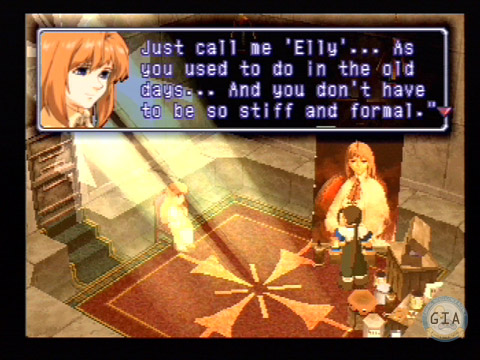
The Old Master Painter
But the most important character holding the story together is neither Miang nor Krelian nor Ramsus; it’s the likable protagonist, Wong Fei Fong. Like few other video game heroes, Fei is a low-key guy who would really prefer to spend his time painting in his small, quiet hometown. (Fei’s mantra, repeated in several times of distress, is that he “doesn’t like Gears or fighting.”) There’s an appealing man-who-too-knew-much aspect to Fei’s story. He’s a regular guy who doesn’t seek out adventure; adventure comes to him, and only because of long-forgotten secret government experiments performed on him as a child. As a viewpoint character, he’s easy to emphasize with because he enters the story knowing as little of the world’s backstory as does the player. Xenogears’s spiritual successor, Xenosaga, fares significantly worse in this regard; its protagonist, Shion, is frequently involved in pivotal plot events that the player doesn’t understand, making her difficult to identify with.
Choosing My Religion
Xenogears’s story and themes sparked interest from the very beginning. Before its release, it was buzzed about due to reports its religious themes might have been deemed too controversial for overseas audiences. While today’s gaming audience might frown upon these kinds of thematic aspirations–“pretentious” is the go-to sneer–it’s important to understand that in 1998, this was the most compelling endorsement imaginable for Xenogears. Video games had just broken out of the era of cartridges and Nintendo-mandated censorship, anime was starting to attract a larger audience, and anything from Japan was considered surely more intellectual and edgy than American media.
In reality, stories of Xenogears’s controversial content was always overblown. Xenogears isn’t an anti-religion polemic; it’s a mostly faithful sci-fi adaptation of Gnosticism, an ultimately rejected movement in early Christianity. Gnostic belief generally viewed our physical world as created in imitation of a spiritual world by an inferior, false god (demiurge) that had stolen power from the true God. Jesus and Sophia (“wisdom”) were sent as emanations of the true God to save humanity. In the Xenogears cosmology, the demiurge is Deus, an ancient AI-guided space weapon designed to terraform planets. As it is being shipped off on the spaceship Eldridge for destruction, Deus escapes its creators, crash lands on the Xenogears world, and re-creates Miang and other humans so they can repair Deus and then be assimilated for energy. Deus is powered by a trapped piece of the Wave Existence, the true God of the Xenogears universe. To escape its imprisonment, the Wave Existence repeatedly reincarnates Fei–the one survivor of the Eldridge wreck–and Elly (known as Sophia in previous incarnations) until they can destroy Deus.
These interesting thematic choice deserve praise, but they’re hardly as outrageous or offensive as originally suggested. One of the few gratuitous uses of religious iconography involves the active party’s Gears being crucified while awaiting rescue. (And, yes, depending on the player’s choice of characters, that might include pink puffball Chu-Chu.) An awkward image? Absolutely, and one that lives on in Internet infamy long after the rest of the game has been forgotten. But lacking deeper symbolism or any meaningful contribution to the plot, this faux pas is quickly resolved and forgotten. That’s why it’s possible to look back favorably on Xenogears long after any supposed controversy has faded; its appeal was always in a carefully-planned, well-told story, not in subversive shock value. Indeed, the presence and support of the godlike Wave Existence is a more positive role for the divine than many other video game stories, and the game’s Judeo-Christian references are far more accurate and better researched than many of its contemporaries.
Magna Carta Perfect Works
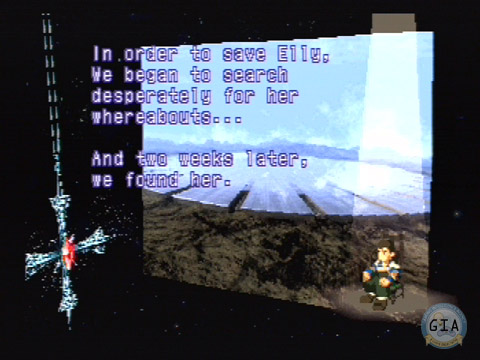
He Gives Speeches
Still, it’s clear from Xenogears’s themes and scope that it aspired to far more than most video games, and it’s not surprising it didn’t hit every target. Even after the game’s release date had been pushed back once, the development team didn’t have enough time to implement all of the intended dungeons and story scenes. To complete the story, Disc 2 includes a number of sequences in which Fei simply narrates events from a chair–using text and static illustrations–before the player jumps ahead to the described boss battle or dungeon. Although this decision has always been one of the most commonly criticized aspects of Xenogears, it deserves a reappraisal. Wrapping up the saga via narration is certainly better than how many modern games handle the same situation – excising plot points entirely or cutting off mid-story with a dissatisfying “To Be Continued…”
Indeed, the tantalizing nature of these unfinished sequences may even contribute to the mystique of Xenogears’s universe. Like other famously incomplete works–the Beach Boys’ SMiLE album, or the animated epic The Thief and the Cobbler, for example–there’s an instinctive drive to piece together what could have been. Anyone remotely familiar with RPG conventions can imagine where additional dungeons and events would have been placed: locations like the Mass Driver facility and the arctic cave holding the Zohar device were clearly meant to be fleshed out into actual dungeons, and the unexplained appearance of a new special ability on Billy’s Gear suggests a story scene that would have conferred it. Other events make less of an impression in summary form than they were probably meant to: Deus’s attempt to mutate humans into a form it can more easily assimilate could have been fleshed out into a major crisis. The thought of what “might have been” is a large part of why Xenogears has such a hold on its fans; the unfinished parts of Xenogears can be imagined to be as fantastic as possible.
The desire to fill in the details also drove fervent interest in Xenogears’s Japan-only art book, Xenogears Perfect Works. Although Xenogears can be understood without any additional material, Perfect Works provides intriguing information about minor characters and the “Episodes” covering Fei and Elly’s previous, slain incarnations. (Much like Star Wars, Xenogears portrays itself as “Episode V” of an ongoing saga; the contents of the final Episode VI remain one of its most enduring mysteries.)
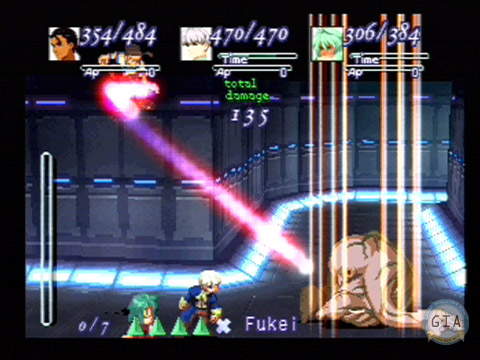
I’m in Great Shape
Kick, Punch, It’s All in the Mind
While any retrospective of Xenogears now starts and ends with its sprawling story, before its release, Xenogears also received substantial buzz for introducing mecha into an RPG. Xenogears implements these giant robots in its dual battle systems, with many confrontations on foot and others in the characters’ giant mechanized Gears.
The on-foot combat promises a great deal by allowing characters to save or spend “action points” to string together different combinations of moves, but the best play almost always just spends all of points on the strongest attack possible. The Gear battle system is significantly more interesting. Resources must be carefully managed: Neither HP (health) nor fuel (required for most attacks) can be easily restored, and equipping a Gear often presents a trade-off between maximizing attack power versus fuel capacity. A Gear’s offensive capacity waxes and wanes over turns: standard attacks build up an Attack Level stat that can be expended to execute a super move. Again, the game doesn’t capitalize on these elements that much, but there are some great boss battles. One challenges you to time the rise of your Attack Level with the times when Miang’s defenses are weakest, for example, while another asks you to position yourself to inflict maximal damage during a brief period before Hammer self-destructs. It’s somewhat ironic that game mostly remembered for it story has some of the most strategic bosses in the PSone RPG era; it’s rather unfortunate that most of the fights don’t exploit the system to its fullest extent.
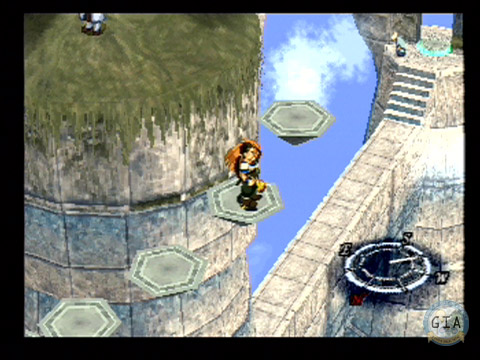
Wind Chimes
Outside of battle, there’s one other quirk. Locations are 3D polygonal environments with sprite-based characters superimposed on top, a popular technique in the PSone era. But Xenogears twists this convention by adding platforming: There’s a jump button, and progress through many dungeons requires hopping from ledge to ledge. Modern gamers might easily quibble that the platforming is totally unrelated to the rest of the game mechanics, and they’d be right. But, for better or worse, the threat of a missed jump certainly adds to the experience of the epic Babel Tower dungeon, in which falling off a ledge (or being attacked in mid-air) can set you a substantial distance back. Although it’s dubious whether that’s really a feature, it certainly makes scaling the tower into a memorable, if hair-rending, experience; the floating city at the top feels as remote and unobtainable to the player as it is to the characters.
These mechanics speaks to something about why Xenogears, despite its heavy emphasis on story, still works as a game. Tricky boss battles make the antagonists feel like true enemies, and the time spent venturing through dungeons fills in the beats between plot points and lets the story breathe. The removal of that sense of pacing might be the biggest loss on Disc 2.
The First and the Last
And so Xenogears’s legacy is an odd one. Having not quite accomplished everything it set out to do, it provides ample opportunity for some other game to come along and outdo it. But while numerous RPGs quickly seized on the trope of the heroes breaking a reoccurring cycle, the scale and tight plotting of Xenogears were never quite replicated or even attempted. Dragon Quest VII has as many hours of gameplay as Xenogears, but a far more episodic structure and storyline.
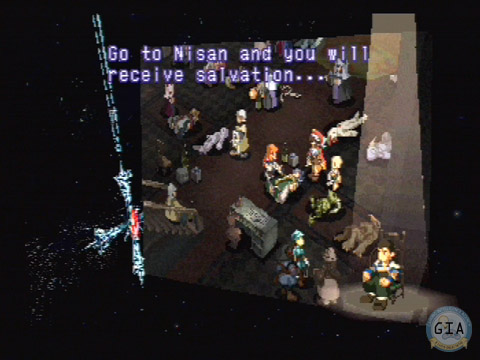
Our Prayer
What’s most striking is that no one seemingly wants to make Xenogears anymore even if they somehow had the resources to build such a sprawling game in high definition. More than anything, Xenogears represents the aspirational spirit of its era. Video games had recently jumped from 2D to 3D, from cartridges to CDs. Games were expanding to a wider audience, every year making massive leaps in gameplay complexity, graphical fidelity, and narrative complexity. In that era of optimism, there seemed to be no end to where games might go next. An 80-hour RPG packed with multiple battle systems and complex religious themes seemed like the next logical step, probably only a prelude to the next great innovation. But instead, lengthy single-player narratives have given way to minimalist arcade games and multiplayer experiences designed to endure for months.
By modern standards, Xenogears’s extensive cutscenes and relentless single-player focus are an aberration, and the audience that once made Xenogears such a sensation seems to have been passed over entirely. But those fans still exist, and are sorely underserved. It can’t be wise to ignore that there are plenty of people who prefer a reluctant hero over macho marines and discussing narrative intricacies over maximizing their damage-per-second. Until the day that audience is remembered, Xenogears may remain a peculiar sort of evolutionary dead-end: a game that set the bar in its particular niche high enough that it might never be reached again; the alpha and omega of story-driven RPGs.
Please visit the GIA Archive for hundreds of screenshots of Xenogears.
16 Responses to Xenogears: Alpha and Omega
Leave a Reply
You must be logged in to post a comment.

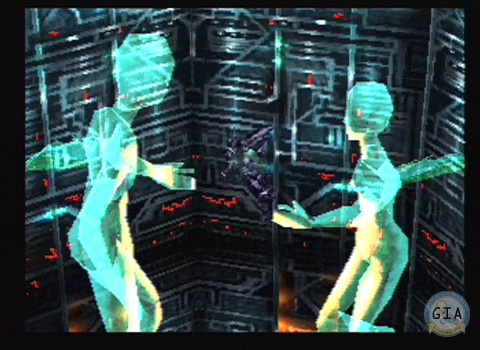
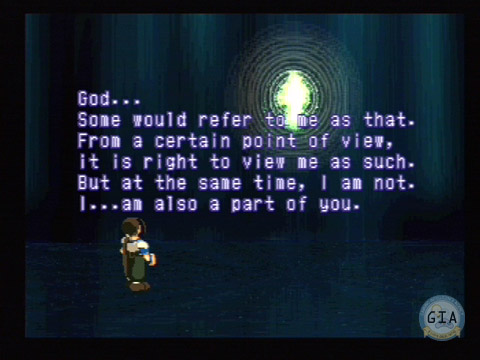
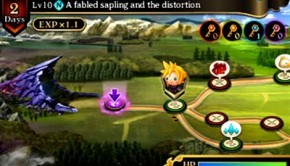
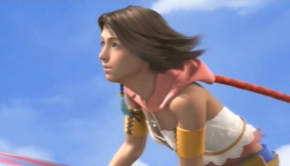
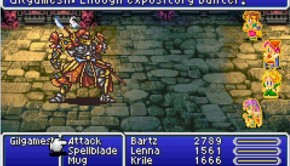





Fritz, thanks for coming back to the GIA fold to finish this much-missed Vault! Also, I am leaving the first ever comment on the new GIA!
I had read this earlier and loved it. Knowing Fritz did it only sweetens the pot.
Very good read.
I had a friend who thoroughly enjoyed Xenogears. This friend used to be anti-RPG (most of my friends were). It was actually Final Fantasy VII that got him initially engaged. He drove me down to the mall to pick it up. Had my Final Fantasy VII shirt on and everything. Once he saw me playing and saw the cutscenes, he was sold…RPG gamer ever since, at long as cutscenes were in it.
Enter Xenogears. I purposely skipped it because I’m not a fan of robot games for some reason. I played it later when it came to the PlayStation Store, and I admit I was intrigued at least at first; but then it just got boring, and some of the dungeons were just stupid. Difficult to follow where to go, and difficult to piece out what you were supposed to do in some boss fights.
I came to accept that I’m just more a fan of games like those offered by the late-great Working Delays.
Great article! You should also do a review on the Xenosaga triology 🙂
Thanks; I’m glad you liked it!
I’m afraid I wouldn’t be qualified to do a Xenosaga retrospective; I only played the first in that series. I have to admit that–as I kind of indicated in this article–I didn’t care for it as much as XG, so I was never motivated enough to go through the sequels.
I definitely see why you feel that way about Shion, and I agree to some extent. But I still urge you to at least finish the game and the story–it made me adore Xenogears even more after having finished Xenosaga. I’d love to see a review for it from you :P.
Blue Blue Blue Green…
I am utterly horrif– fascinated. Utterly fascinated that The GIA is back. And so is Fritz.
To keep this comment relative to the article, one of the other ways that you can see how much people still have an interest in Xenogears is to look at the price – as of today, Amazon lists various “new” condition copies of the game starting at $97.99. There aren’t that many games that still hold on to such a price for so long after they’ve been released.
Good point! And that’s despite the game being available on the PlayStation Network, right?
Great read, one of my favorite part of xenogears you didn’t hit on was the music. Never played another RPG that the music complimented the emotion so well. Truely great.
Thanks! The music is something a number of people have mentioned, and I would have liked to find room to talk about it.
The soundtrack was Mitsuda’s first major solo work, I believe. I like it a lot although with such a long game, the 2 discs’ worth of tracks doesn’t feel like quite enough. The arranged album, CREID, is great. (not a Creed album — thank goodness!)
Xenosaga II is much weaker than the first game and not really worth playing (it doesn’t even advance the story all that much), but Xenosaga III is excellent and comes closest to matching Xenogears, in my opinion.
The lack of references to the other Xeno- games stood out to me in this article since you mention that nobody seems to want to remake Xenogears. That’s simply not true, as the main man in charge of Xenogears, Tetsuya Takahashi, has twice now attempted projects just as or more ambitious than Xenogears (and he’s going at it again with the mysterious game X in development for the Wii U). Xenosaga went for a larger narrative scope, as it was intended to span six games (but only ended up being three), while Xenoblade has far more game content than Xenogears (I think it took me about 130 hours to complete it). I don’t think either of those projects turned out as well as Xenogears did, since Xenogears has the best balance between narrative and gameplay among the three series, but the game’s original creator certainly wants to to surpass his older work and his attempts should be acknowledged whether or not you played all of these newer games.
Great take on the game. I will always have problems with its failings, but most of those failings came because the game’s reach exceeded its grasp.
Yeah, the unfavorable reception to Xenosaga II was part of why I dropped out of following the series, and then it was just too much to catch up when III came around. Thanks for your comments!
Thanks; glad you liked it!
Excellent review! Still by far one of the best if not THE best RPG! It held a deep story, as well as characters that you really got attached to. Even Chu-Chu didn’t bother me with his pre-Jar Jar Binks-esque type character. The music as mentioned by others is still one of the greatest video game soundtracks. Just a solid game all around!